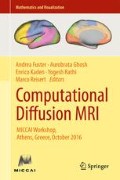Abstract
Microstructural measures from diffusion MRI have been used for classification purposes in neurodegenerative and psychiatric conditions. Novel diffusion reconstruction models can lead to better and more accurate measures of tissue properties: each measure provides different information on white matter microstructure in the brain, revealing different signs of disease. The diversity of computable measures makes it necessary to develop novel classification procedures to capture all of the available information from each measure. Here we introduce a multichannel regularized logistic regression algorithm that classifies individuals’ diagnostic status based on several microstructural measures, derived from their diffusion MRI scans. With the aid of a TV-L1 prior, which ensures sparsity in the classification model, the resulting linear models point to the most classifying brain regions for each of the diffusion MRI measures, giving the method additional descriptive power. We apply our regularized regression approach to classify Alzheimer’s disease patients and healthy controls in the ADNI dataset, based on their diffusion MRI data.
Access this chapter
Tax calculation will be finalised at checkout
Purchases are for personal use only
References
Basser, P.J., et al.: MR diffusion tensor spectroscopy and imaging. Biophys. J. 66(1), 259–267 (1994)
Leow, A.D., et al.: The tensor distribution function. Magn. Reson. Med. 61(1), 205–214 (2009)
Tuch, D.S.: Q-ball imaging. Magn. Reson. Med. 52(6), 1358–1372 (2004)
Tournier, J.D., et al.: Direct estimation of the fiber orientation density function from diffusion-weighted MRI data using spherical deconvolution. Neuroimage. 23, 1176–1185 (2004)
Zhang, H., et al.: Axon diameter mapping in the presence of orientation dispersion with diffusion MRI. Neuroimage. 56(3), 1301–1315 (2011)
Gramfort, A., et al.: Identifying predictive regions from fMRI with TV-L1 prior. In: 3rd International Workshop on Pattern Recognition in Neuroimaging, Philadelphia, PA, 2013, pp. 17–20 (2013)
Nir, T., et al.: Effectiveness of regional DTI measures in distinguishing Alzheimer’s disease, MCI, and normal aging. Neuroimage Clin. 3, 180–195 (2013)
Graña, M., et al.: Computer aided diagnosis system for Alzheimer disease using brain diffusion tensor imaging features selected by Pearson’s correlation. Neurosci. Lett. 502(3), 225–229 (2011)
Haller, S., et al.: Individual prediction of cognitive decline in mild cognitive impairment using support vector machine-based analysis of diffusion tensor imaging data. J. Alzheimers Dis. 22(1), 315–327 (2010)
O’Dwyer, L., et al.: Using support vector machines with multiple indices of diffusion for automated classification of mild cognitive impairment. PLoS One. 7(2), e32441 (2012)
Holmes, C.J., et al.: Enhancement of MR images using registration for signal averaging. J. Comput. Assist. Tomogr. 22(2), 324–333 (1998)
Leow, A.D., et al.: Statistical properties of Jacobian maps and the realization of unbiased large-deformation nonlinear image registration. IEEE Trans. Med. Imaging. 26(6), 822–832 (2007)
Pasternak, O., et al.: Free water elimination and mapping from diffusion MRI. Magn. Reson. Med. 62(3), 717–730 (2009)
Klöppel, S., et al.: Automatic classification of MR scans in Alzheimer’s disease. Brain. 131(3), 681–689 (2008)
Lerch, J.P., et al.: Automated cortical thickness measurements from MRI can accurately separate Alzheimer’s patients from normal elderly controls. Neurobiol. Aging. 29(1), 23–30 (2008)
Magnin, B., et al.: Support vector machine-based classification of Alzheimer’s disease from whole-brain anatomical MRI. Neuroradiology. 51(2), 73–83 (2009)
Wee, C.Y., et al.: Enriched white matter connectivity networks for accurate identification of MCI patients. Neuroimage. 54(3), 1812–1822 (2011)
Cuingnet, R., et al.: Spatial and anatomical regularization of SVM: a general framework for neuroimaging data. IEEE Trans. Pattern Anal. Mach. Intell. 35(3), 682–696 (2013)
Bloy, L., et al.: HARDI based pattern classifiers for the identification of white matter pathologies. Med. Image Comput. Comput. Assist. Interv. 14(2), 234–241 (2011)
Nagy, Z., et al.: Using high angular resolution diffusion imaging data to discriminate cortical regions. PLoS One. 8(5), e63842 (2013)
Acknowledgment
This work is partially supported by an NIH U54 grant to the ENIGMA Center for Worldwide Medicine, Imaging & Genomics.
Author information
Authors and Affiliations
Consortia
Corresponding author
Editor information
Editors and Affiliations
Rights and permissions
Copyright information
© 2017 Springer International Publishing AG
About this paper
Cite this paper
Villalon-Reina, J.E. et al. (2017). Using Multiple Diffusion MRI Measures to Predict Alzheimer’s Disease with a TV-L1 Prior. In: Fuster, A., Ghosh, A., Kaden, E., Rathi, Y., Reisert, M. (eds) Computational Diffusion MRI. MICCAI 2016. Mathematics and Visualization. Springer, Cham. https://doi.org/10.1007/978-3-319-54130-3_13
Download citation
DOI: https://doi.org/10.1007/978-3-319-54130-3_13
Published:
Publisher Name: Springer, Cham
Print ISBN: 978-3-319-54129-7
Online ISBN: 978-3-319-54130-3
eBook Packages: Mathematics and StatisticsMathematics and Statistics (R0)

